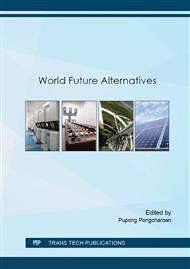p.107
p.114
p.119
p.124
p.130
p.136
p.142
p.151
p.159
Techno-Economic Performance Evaluation and Enhancement for a PV – Diesel Hybrid System
Abstract:
In this research paper, an illustration for system size optimization for a stand-alone PV – diesel hybrid system is obtained. The requirement is to obtain an optimal size that can meet energy demand at an optimized cost for a given lifetime period of the project, this will be achieved using HOMER software to further improve the system parameters like performance ratio, renewable energy fraction, MATLAB will be used. This research study will be done basing on a system currently installed at the School of Renewable Energy, Naresuan University (SERT), this system has a capacity of 120 kW, and it is a hybrid system with PV array, Diesel generator and battery storage system. The cost parameters that will be addressed are; - Net present cost (NPC), Cost of Energy (COE), Capital cost (CC). The initial size of the hybrid system is PV-120kW, Diesel generator -100kW and battery storage of 200kWh after modelling and simulation with HOMER software using special models to show the predicted performance of the final outcome, the optimal size created has a PV size of 100kW, diesel generator with a size of 100kW and battery storage of 100kWh and compared to the initial system COE od 1.01$/kWh, the optimal size has a COE of 0.934$/kWh.
Info:
Periodical:
Pages:
130-135
Citation:
Online since:
June 2016
Authors:
Keywords:
Price:
Сopyright:
© 2016 Trans Tech Publications Ltd. All Rights Reserved
Share:
Citation:


